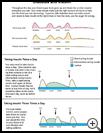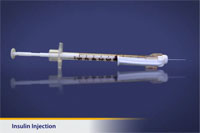
Diabetes: Types and Activity of Insulin
What is insulin used for?
Insulin is a hormone made in the pancreas, an organ inside the abdomen. If your child has type 1 diabetes, he does not make insulin. Your child will need to take insulin shots. Insulin cannot be taken as a pill, because the stomach acid destroys it.
If your child has type 2 diabetes, he may still make insulin, but not enough. He may be able to take pills to help him make more insulin or to better use the insulin he does make.
Your child needs the right kind of insulin at the right times during the day. The amount and kind of insulin is very important. If your child takes too much insulin or takes it at the wrong time, your child could have a serious low blood sugar reaction. If your child doesn't take enough insulin, the body will not be able to use the food for energy and the blood sugar will be too high.
How does it work?
When you have type 1 diabetes, there is a loss of the cells that make insulin. When you eat, your body turns the food into sugar. The sugar is carried through the blood. Insulin helps your body turn the sugar into energy. Throughout the day your blood sugar levels go up and down.
Your body naturally makes the right amount of insulin to move sugar from the blood into the cells where it is burned for energy. Your body cannot turn sugar into energy without insulin. If insulin is not available, sugar builds up in the blood and then starts to spill over into in the urine.
There are three major types of insulin:
- rapid acting insulin that starts to work in 10 to 15 minutes and lasts up to 4 hours
- intermediate-acting insulin that starts to work in 1 to 2 hours and lasts up to 15 hours
- long-acting insulin that starts to work in 1 to 2 hours and lasts 24 hours
Your child's provider may prescribe a combination of different types of insulin to match your child's eating schedule and lifestyle.
What else do I need to know about this medicine?
- Follow the directions that come with your child’s medicine, including information about food or alcohol. Make sure you know how and when your child needs to take the medicine. Your child should not take more or less than he or she is supposed to take.
- Try to get all of your child’s prescriptions filled at the same place. Your pharmacist can help make sure that all of your child’s medicines are safe to take together.
- Keep a list of your child’s medicines with you. List all of the prescription medicines, nonprescription medicines, supplements, natural remedies, and vitamins that your child takes. Tell all healthcare providers who treat your child about all of the products your child takes.
- Many medicines have side effects. A side effect is a symptom or problem that is caused by the medicine. Ask your healthcare provider or pharmacist what side effects the medicine may cause, and what you should do if your child has side effects.
If you have any questions, ask your healthcare provider or pharmacist for more information.
Last modified: 2011-08-08
Last reviewed: 2011-06-28


